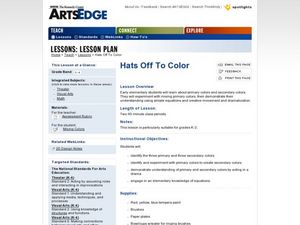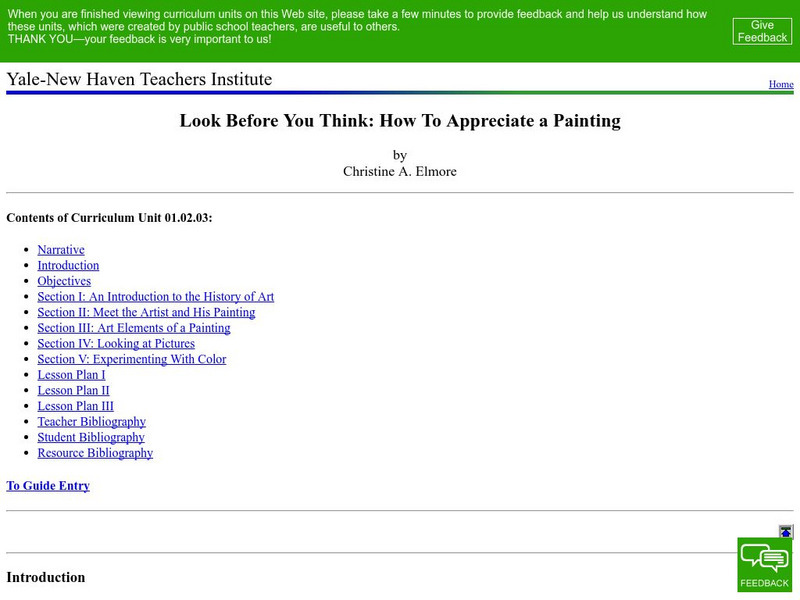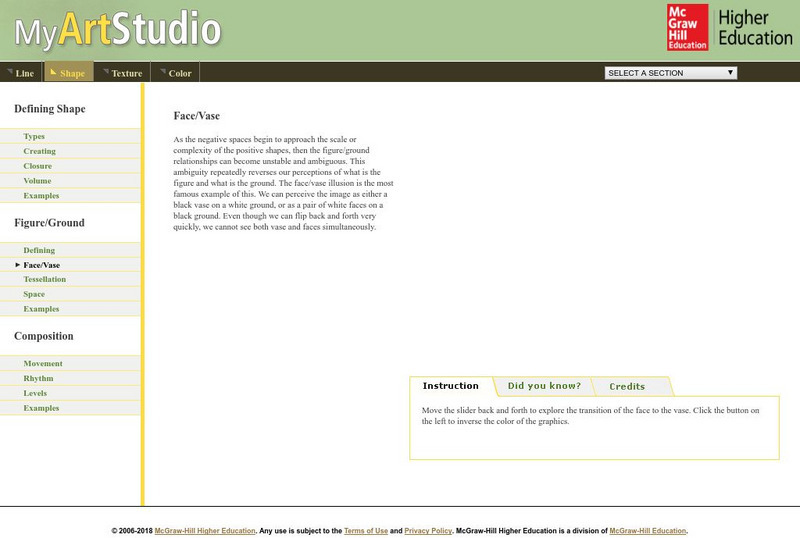Curated OER
Looking and Learning in the Art Museum
Reflect on the art your class can view at a museum. For this art history lesson, young scholars draw six elements of art. They discuss original art versus reproduction artwork and write about their thoughts of a museum. It would be...
Curated OER
Elements of Art - Memoir Book
Learn and practice the elements of art by making a picture book. Also containing short memoirs of their own lives, this would be a perect project and also a gift to take home. In doing this project, they also gain an understanding of the...
Curated OER
Cardboard Weaving
Fifth graders observe artworks of cardboard weaving for their art elements and principles of organization. In this cardboard weaving activity, student create their own and compare artworks of the past and present. Students self evaluate...
Curated OER
Rhythm and Art: Elements of Art
Students discover the three elements of art. In this visual arts lesson, students examine line, shape, and color of works by Torres-Garcia and Picasso. Students then identify the elements of art in works by other artists.
Curated OER
Identify the Element of Line
Learners explore the element of "line." In this beginning art lesson, students listen to the book Harold and the Purple Crayon, then describe the types of lines Harold drew. Learners identify straight lines, jagged lines, curvy lines,...
Curated OER
Hats Off to Color
Students investigate primary and secondary colors. In this art lesson, students mix primary paint colors to develop secondary colors. Students identify each color they created.
Curated OER
Mysteries of the Past-An Artistic Expedition
Students explore expression in artwork. In this interdisciplinary lesson, students travel to ancient Egypt to examine abstract art of the Nile River valley through several hands-on activities.
Curated OER
Walking the Line
Students participate in activities that engage all learning styles (such as picture walks, tracing lines, movement/theatre technique) as an introduction to the art element of line and its importance to art.
Curated OER
Recycling With Art
Students create works of art from recyclable materials. In this visual arts lesson, students investigate works of art created from recyclable materials. Students choose an emotion to convey and then create an art piece from materials...
Curated OER
Line Up! Shape Up! Color the World!
Students explore the Elements of Art. In this art lesson, students read the book Katie Meets the Impressionists and brainstorm the different things that artists create. Students observe various elements of art such as line and color and...
Curated OER
Walk into the Desert, A Line and Wash Landscape
Students discuss a landscape art print and its composition. They create a landscape underdrawing with foreground, middleground and background as well as repeated elements for rhythm. They add a watercolor wash and lights/darks for...
Curated OER
Theatre Prop Design and Construction
Fourth graders construct individual props. In this theatrical arts lesson, 4th graders use the elements of art to create various props using paper mache. Students construct objects such as logs, fruit, and a picture frame.
Curated OER
How to "read" a painting
Students follow a structured method of critiquing an art work to discover its substance and meaning. They apply four distinct steps to critique a painting which are: describe, analyze, interpret, and judgment.
Curated OER
Values and Composition
Students examine and analyze the values of gray and the composition in photographs by Ansel Adams. They discuss elements of art, draw shapes and lines, complete a tone rectangle, and create a still life drawing.
Curated OER
Letter from the Chateau
Students write a friendly letter based on their observations of a painting by Poussin.
Cornell University
Cornell University: Art, Design, and Visual Thinking
Use the left-hand toolbar of this site to investigate an online textbook for the language of design. It provides visual examples and explanations of line, form, color, color psychology, texture, balance, proportion and many more...
Yale University
Yale New Haven Teachers Institute: How to Appreciate a Painting
Christine A. Elmore's curriculum unit designed "to facilitate her third-graders' enjoyment of and response to fine art." This unit can be applied to all age groups and provides an extensive background on art in general.
ArtLex
Art Lex: Value
Artlex's definition of value and how it applies to black and white and color in art. There are links to other sites to further explain the term and also related terms to explore.
John F. Kennedy Center
The Kennedy Center: Arts Edge: Rhythm and Art
This curriculum unit from the Kennedy Center's ArtsEdge program presents an introduction to the concept of visual rhythm and explores the intersection of visual and auditory rhythm. The unit is divided into six lessons focusing on...
Kinder Art
Kinder Art: Monet's Garden by the Sea
A great lesson plan using oil pastels where the student looks at Monet's "Garden at Saint-Adresse," and then creates their own composition focusing on foreground, middleground and background.
Department of Defense
Do Dea: Art Appreciation: Unit 3: Technical Aspects of Art
In this third unit of a course on Art Appreciation, students learn how to describe the technical aspects of an artist's work by discussing elements of art and principles of design. They also look at the stylistic qualities of an artist's...
National Gallery of Art
National Gallery of Art: The Elements of Art: Texture
Students will be introduced to one of the basic elements of art, texture, by identifying different types of textures found in multiple works of art and hypothesize what materials and techniques were used to achieve that texture. Then,...
McGraw Hill
My Art Studio: Elements of Art: Composition: Rhythm
Interactive activity explaining the principle of rhythm as it applies to visual art.
McGraw Hill
My Art Studio: Elements of Art: Face/vase
Explanation of the use of positive and negative space to define figures in a composition.






















